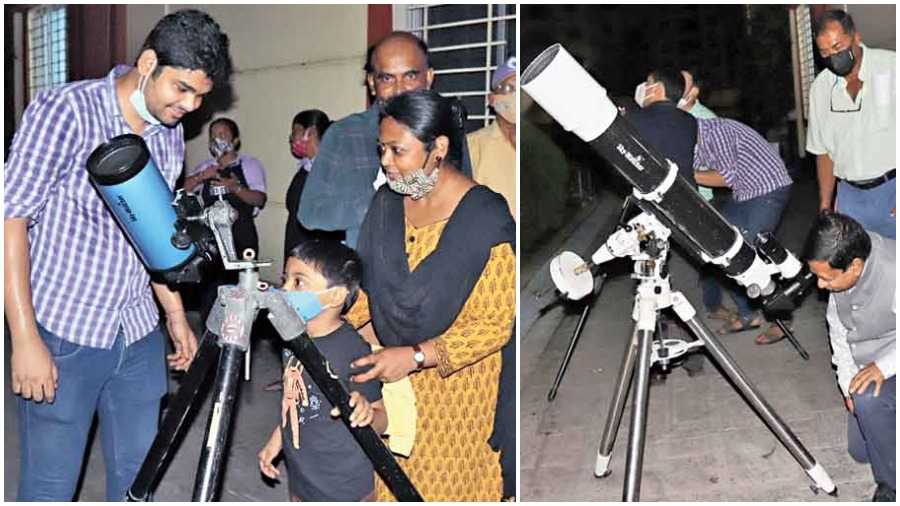A sky gazing club has formed in New Town that hopes to bring together like-minded enthusiasts to watch celestial bodies as well as discuss and learn more about them.
The announcement was made at New Town Business Club where members of the 40-year-old Dhakuria-based Sky Watchers Association Kolkata had come to encourage the newbies. They had got two telescopes through which guests were shown Jupiter and Saturn.
“Man doesn’t live by bread alone. He needs music, dance, poetry…something beyond his career,” noted Debashis Sen, managing director of Hidco. “If someone teaches you about the galaxy it will arouse interest and hopefully even inspire children to take up space technology later.”
Avinaba Dhar, a founder member of the new club Stargaze- The Infinity Explorer, was excited at the prospect. “Not only am I interested in the subject but I also want to introduce my four-year-son to it. It’s important that he realises there’s life outside the smart phone and he’ll watch the stars if I watch the stars,” he said.
Look up & watch
“People are turning towards nature these days and the sky is but an extension of that. Yes, it’s technical but we’re into observation of astronomy and not the science of it,” said Saikat Bhadra, addressing novices on behalf of Sky Watchers Association Kolkata.
On the first three days of sky gazing, he said, one looks for Saturn, Jupiter and other stars and planets. “But thereafter, it’s your imagination. Seeing how vast the universe is, one starts appreciating the grand scale of things and introspecting as to who we are, where we have come from and what our final destination is.”
Our ancestors would watch the sky to plan agriculture, navigate the seas and make calendars but today amateurs hunt for new planets, asteroids and study solar activities. “Professionals don’t have time for all aspects of astronomy and sometimes rely on amateurs’ findings too,” Bhadra said.
He singled out sky watching as a social hobby as opposed to say, photography, that one pursues alone. “This hobby brings people together where they use clues to solve a kind of treasure hunt to locate celestial bodies,” he said.
Star-gaze pointers
Secretary of the Dhakuria-based group, Dipankar Dey, told the audience about “dark adaptation”.
“In case of a power cut at night we initially go blind and see nothing. But after few moments, our pupils dilate and we can distinguish the furniture and figures around with whatever little light is available. It’s the same with the sky,” Dey said.
So don’t be disappointed if you crane your neck up at the sky and barely see a twinkle. “Give your eyes 15 to 20 minutes to adapt to the darkness and you’ll start seeing three times more stars than you started with,” he promised.
There’s also the issue of light pollution. “The city sky at night doesn’t seem black anymore; it’s hazy and grey. This is because of light from homes and streets that spill overhead. Streetside hoardings, for instance, throw light at the messages from the bottom. If approaching Calcutta from the suburbs, the city seems to have a dome of light overhead. These intense lights make it difficult to see the stars,” said Dey, adding that the New Town sky was a tad better than the rest of the city as it was less populated.
Also, there is dust. “As per the Bortle scale, that measures the darkness of a night sky on a scale of one to 9, Calcutta gets 9, which is the worst! Places like Sikkim get 3,” Dey said.
Read the map
There are more than 5-6,000 stars visible to the naked eye but how to recognise them? “Why, you use a map, of course,” said Dey. His team promised to come over and teach new members how to read this map. “With knowledge of the sky map one can identify stars on any day standing anywhere in the world.”
And how to read the map under a dark sky? “For this, we recommend getting a torch, covered by red cellophane paper. This produces a dim red light that does not interfere with dark adaptation.”
The Infinity Explorer
Where: New Town Business Club
Activities: Once a month meetings take place to watch the sky through telescopes, interact with experts. Excursions are held to watch the sky during phenomena such as eclipses. A library corner is being set up too, with books on astronomy
Eligibility: Open to all but New Town residents to be given preference
